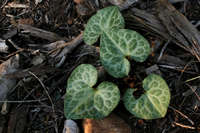Herbs , perennial, deciduous, rhizomatous, without aerial stems. Leaves alternate (sometimes appearing opposite because of crowding), 2-ranked; stipules absent; petiolate foliage leaves and sessile, triangular scale-leaves both present. Leaf blade membranous or leathery, pubescent at least abaxially and on margins. Inflorescences terminal on rhizome, flowers solitary; bracts absent. Flowers: sepals distinct, usually mixture of white, green, tan, red, or purple, proximally touching valvately and forming well-defined false tube, externally usually villous, inner surface strigose, smooth or with weak longitudinal ribs, never with network of low ridges; vestigial petals present or absent; stamens 12, distinct; filaments longer than pollen sacs; terminal appendage of anther well developed; ovary inferior, 6-locular; styles connate in column. Capsule fleshy, dehiscence irregular. Seeds ovoid, not winged, with fleshy appendage. x = 13.
The species seem amply distinct, but herbarium material can be difficult to key for several reasons. First, the diagnostic colors of some organs (especially of the connective and the inner hairs of the calyx) often darken on drying. Second, immature flowers and young fruit are superficially similar to mature flowers, but color and posture of floral organs may be different at those stages. For instance, posture of the distal portion of sepals at anthesis (whether erect, spreading, or reflexed) is diagnostic for the species, but sepals in all species are erect in bud and in fruit. Third, as in Hexastylis , distortion of the flower in pressing makes it difficult to interpret calyx structure. In particular, the distinction between proximal portions of the sepals, which meet valvately to form a well-defined false calyx tube, and distal portions, which do not, is obvious in fresh material but often unclear in the herbarium.
The flowers of Asarum are predominantly self-pollinated, but they are occasionally visited by mycotrophic flies (K. L. Lu 1982).
Cal regular, tubular below, deeply 3-lobed, hairy outside; pet none or vestigial; stamens 12, with well developed filament, closely appressed to the styles; connective prolonged as a subulate tip; ovary inferior, 6-locular; styles coherent in a column, expanded at the tip into a 6-lobed stigma; fr capsular, opening irregularly; seeds large, ovoid, wrinkled, carunculate; herbs, the elongate rhizome producing annually a pair of petiolate, broad, membranous, hairy lvs, these deciduous at the end of the season; fls solitary, red-brown, short-peduncled, arising between the pair of lvs. 90, N. Hemisphere.
Gleason, Henry A. & Cronquist, Arthur J. 1991. Manual of vascular plants of northeastern United States and adjacent Canada. lxxv + 910 pp.
©The New York Botanical Garden. All rights reserved. Used by permission.







